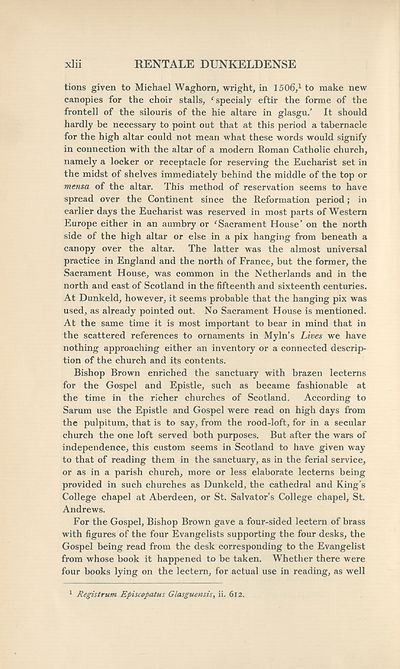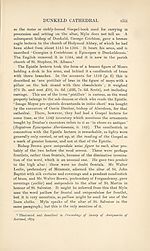Series 2 > Rentale Dunkeldense
(55) Page xlii
Download files
Complete book:
Individual page:
Thumbnail gallery: Grid view | List view

xlii
RENTALS DUNKELDENSE
tions given to Michael Waghorn, wright, in 1506,1 to make new
canopies for the choir stalls, ‘specialy eftir the forme of the
frontell of the silouris of the hie altare in glasgu.’ It should
hardly be necessary to point out that at this period a tabernacle
for the high altar could not mean what these words would signify
in connection with the altar of a modern Roman Catholic church,
namely a locker or receptacle for reserving the Eucharist set in
the midst of shelves immediately behind the middle of the top or
memo, of the altar. This method of reservation seems to have
spread over the Continent since the Reformation period; in
earlier days the Eucharist was reserved in most parts of Western
Europe either in an aumbry or ‘Sacrament House’ on the north
side of the high altar or else in a pix hanging from beneath a
canopy over the altar. The latter was the almost universal
practice in England and the north of France, but the former, the
Sacrament House, was common in the Netherlands and in the
north and east of Scotland in the fifteenth and sixteenth centuries.
At Dunkeld, however, it seems probable that the hanging pix was
used, as already pointed out. No Sacrament House is mentioned.
At the same time it is most important to bear in mind that in
the scattered references to ornaments in Myln’s Lives we have
nothing approaching either an inventory or a connected descrip¬
tion of the church and its contents.
Bishop Brown enriched the sanctuary with brazen lecterns
for the Gospel and Epistle, such as became fashionable at
the time in the richer churches of Scotland. According to
Sarum use the Epistle and Gospel were read on high days from
the pulpitum, that is to say, from the rood-loft, for in a secular
church the one loft served both purposes. But after the wars of
independence, this custom seems in Scotland to have given way
to that of reading them in the sanctuary, as in the ferial service,
or as in a parish church, more or less elaborate lecterns being
provided in such churches as Dunkeld, the cathedral and King’s
College chapel at Aberdeen, or St. Salvator’s College chapel, St.
Andrews.
For the Gospel, Bishop Brown gave a four-sided lectern of brass
with figures of the four Evangelists supporting the four desks, the
Gospel being read from the desk corresponding to the Evangelist
from whose book it happened to be taken. Whether there were
four books lying on the lectern, for actual use in reading, as well
1 Registrum Episcopatus Gtasguensis, ii. 612.
RENTALS DUNKELDENSE
tions given to Michael Waghorn, wright, in 1506,1 to make new
canopies for the choir stalls, ‘specialy eftir the forme of the
frontell of the silouris of the hie altare in glasgu.’ It should
hardly be necessary to point out that at this period a tabernacle
for the high altar could not mean what these words would signify
in connection with the altar of a modern Roman Catholic church,
namely a locker or receptacle for reserving the Eucharist set in
the midst of shelves immediately behind the middle of the top or
memo, of the altar. This method of reservation seems to have
spread over the Continent since the Reformation period; in
earlier days the Eucharist was reserved in most parts of Western
Europe either in an aumbry or ‘Sacrament House’ on the north
side of the high altar or else in a pix hanging from beneath a
canopy over the altar. The latter was the almost universal
practice in England and the north of France, but the former, the
Sacrament House, was common in the Netherlands and in the
north and east of Scotland in the fifteenth and sixteenth centuries.
At Dunkeld, however, it seems probable that the hanging pix was
used, as already pointed out. No Sacrament House is mentioned.
At the same time it is most important to bear in mind that in
the scattered references to ornaments in Myln’s Lives we have
nothing approaching either an inventory or a connected descrip¬
tion of the church and its contents.
Bishop Brown enriched the sanctuary with brazen lecterns
for the Gospel and Epistle, such as became fashionable at
the time in the richer churches of Scotland. According to
Sarum use the Epistle and Gospel were read on high days from
the pulpitum, that is to say, from the rood-loft, for in a secular
church the one loft served both purposes. But after the wars of
independence, this custom seems in Scotland to have given way
to that of reading them in the sanctuary, as in the ferial service,
or as in a parish church, more or less elaborate lecterns being
provided in such churches as Dunkeld, the cathedral and King’s
College chapel at Aberdeen, or St. Salvator’s College chapel, St.
Andrews.
For the Gospel, Bishop Brown gave a four-sided lectern of brass
with figures of the four Evangelists supporting the four desks, the
Gospel being read from the desk corresponding to the Evangelist
from whose book it happened to be taken. Whether there were
four books lying on the lectern, for actual use in reading, as well
1 Registrum Episcopatus Gtasguensis, ii. 612.
Set display mode to:
![]() Universal Viewer |
Universal Viewer | ![]() Mirador |
Large image | Transcription
Mirador |
Large image | Transcription
Images and transcriptions on this page, including medium image downloads, may be used under the Creative Commons Attribution 4.0 International Licence unless otherwise stated. ![]()
| Scottish History Society volumes > Series 2 > Rentale Dunkeldense > (55) Page xlii |
|---|
| Permanent URL | https://digital.nls.uk/127382721 |
|---|
| Attribution and copyright: |
|
|---|
| Description | Over 180 volumes, published by the Scottish History Society, containing original sources on Scotland's history and people. With a wide range of subjects, the books collectively cover all periods from the 12th to 20th centuries, and reflect changing trends in Scottish history. Sources are accompanied by scholarly interpretation, references and bibliographies. Volumes are usually published annually, and more digitised volumes will be added as they become available. |
|---|


